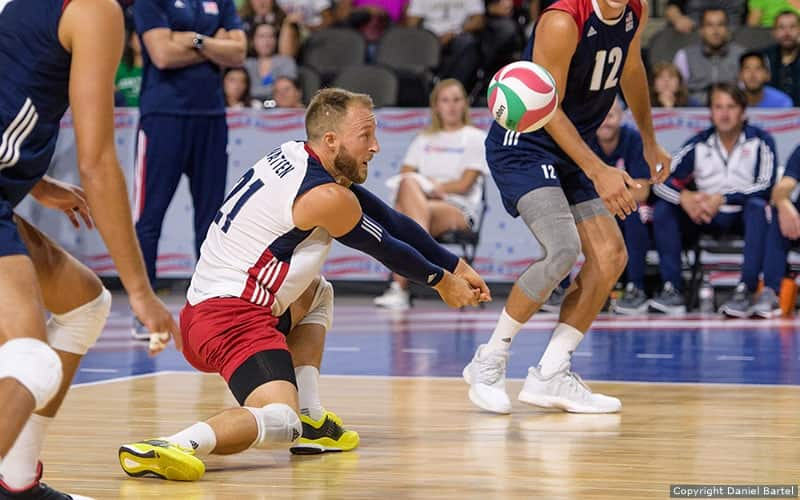
Originally published in the Fall 2018 and Spring 2019 issues of Your Court magazine, the official magazine of USA Volleyball.
Defensive Agility
Dustin Watten, Former U.S. Men's National Team libero
The more I play, the more I realize how important balance and simplicity are in being a consistently great libero. Over the summer, I focused on being balanced and keeping my arms independent when digging quicks and pipes.
Most of the time on defense and serve receive, our arms naturally gravitate toward our midline, even if the ball isn’t going there. Once our arms are connected, only then do we begin tracking and pursuing our perceived line of the ball. This isn’t that big of a problem if we’ve made a great read on the attack and the ball is coming into our midline or slightly outside. But we lose time, balance and control if the ball is outside our body.
If our arms make that default move inward, our platform has to chase the ball, pulling our hips and creating a situation where our midline isn’t facing our desired target. Then, not only do we have to get an accurate contact on the ball, but because our hips have been pulled away, we have to squeeze an intense, precise angle using our inside shoulder to put the ball where we want.
I’ve been fighting the urge to gravitate to the midline by working on moving both arms to the area where I believe the ball will be. If I don’t have enough time to connect, I still have one arm to salvage a huge, quick attack with a great angle, propelling the ball straight up. Try it on your own!
The Transition Game
Jeff Jendryk, U.S. Men's National Team middle blocker
Working hard in transition and being available in less-than-perfect situations are the biggest ways middle blockers can stand out on the court. The best feeling I get during a game is after an attacker gets past the block and my defenders make a great touch to my setter. It doesn’t even matter if the touch is perfect. I have faith in myself and know that I will be able to transition from blocking into the air so my setter can find me.
There are three keys to being great in transition:
- Work hard to get past the 10-foot line.
- Be vocal so your setter knows where to find you.
- Most importantly, maintain an aggressive step close.
Being great in transition is important, but you have to work for it. Time after time. No matter what!
Specialized vs. Multi-Sport Athlete?
Tayyiba Haneef-Park, three-time Olympian and a member of the USAV Board of Directors
Should you specialize or be a multi-sport athlete?
The debate is long and heated. I grew up participating in a wide range of activities including soccer, track, basketball and volleyball. There is so much value in the cross-training that I decided where to attend college based on the schools that would allow me to participate in track and volleyball.
From my own experience, I had fewer injuries, less emotional burnout and more skill crossover than peers who specialized early on. Being a multi-sport athlete better equipped me to take on different roles and responsibilities on and off the court – which became essential in my professional playing years.
Developing sport-specific skills – as well as mental and life skills – makes being a multi-sport athlete an easy choice for me.
Injuries and Recovery
Lauren Fendrick, 2016 beach Olympian
Pay attention to the people trying to get you back to good health, including medical staff and strength coaches. Ask questions about what they recommend and why.
Pay attention to your body. Learn what different sensations mean. Are you feeling fatigue, muscle soreness, injury or something else?
If rehab exercises or drills become dull, find nuance in the exercise. Maybe you've done the same movement 1,000 times, but there's always more to learn.
